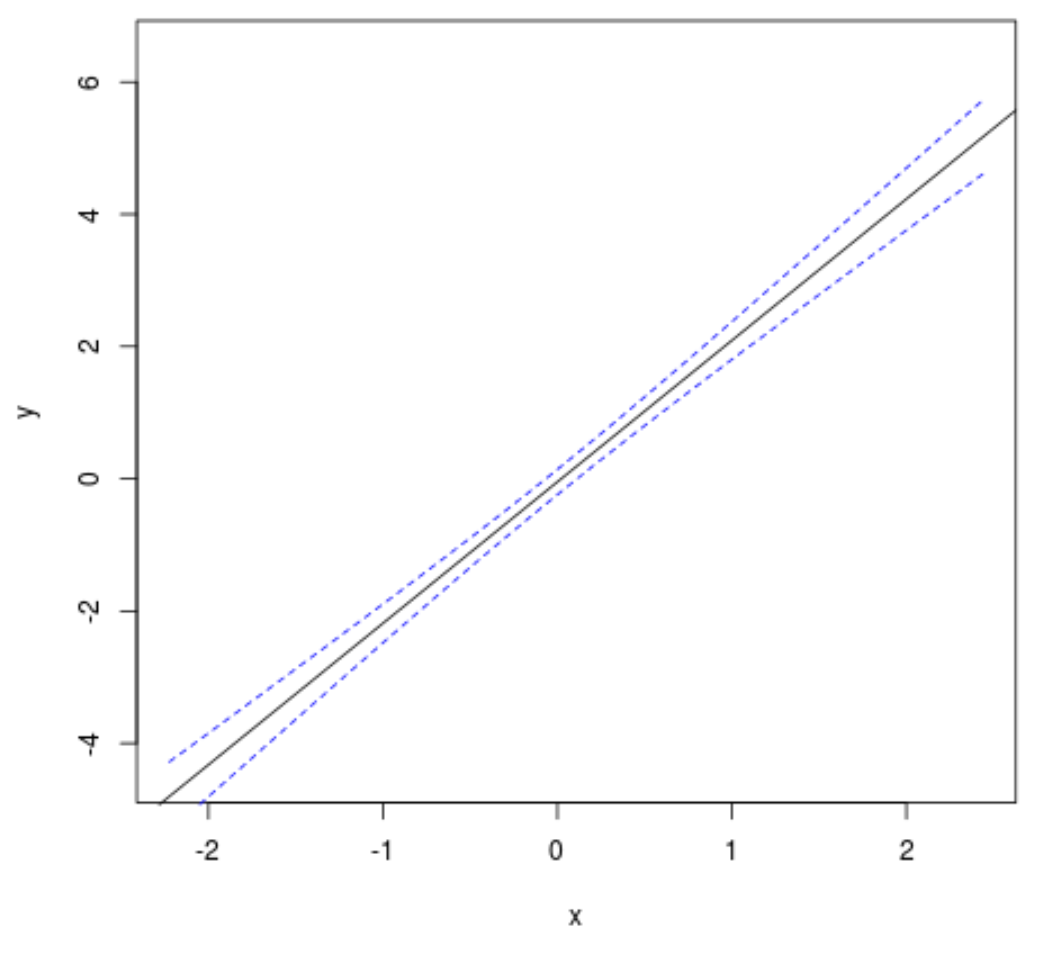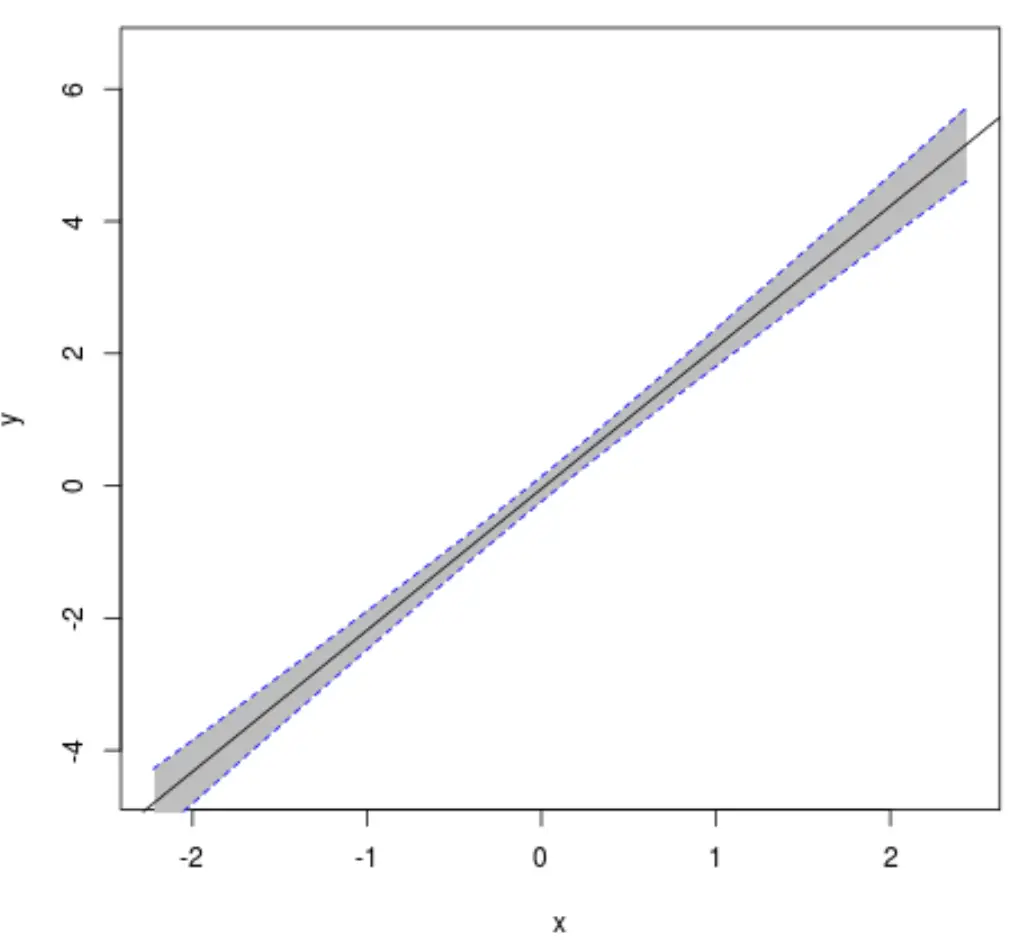วิธีการพล็อตช่วงความเชื่อมั่นใน r
ช่วงความเชื่อมั่น คือช่วงของค่าที่น่าจะมีพารามิเตอร์ประชากรที่มีระดับความเชื่อมั่นที่แน่นอน
บทช่วยสอนนี้จะอธิบายวิธีการสร้างช่วงความเชื่อมั่นสำหรับชุดข้อมูลใน R
ตัวอย่าง: การวางแผนช่วงความเชื่อมั่นใน R
สมมติว่าเรามีชุดข้อมูลต่อไปนี้ใน R ซึ่งมี 100 แถวและ 2 คอลัมน์:
#make this example reproducible set.seed(0) #create dataset x <- rnorm(100) y <- x*2 + rnorm(100) df <- data.frame(x = x, y = y) #view first six rows of dataset head(df) xy 1 1.2629543 3.3077678 2 -0.3262334 -1.4292433 3 1.3297993 2.0436086 4 1.2724293 2.5914389 5 0.4146414 -0.3011029 6 -1.5399500 -2.5031813
ในการสร้างกราฟความสัมพันธ์ระหว่าง x และ y ขั้นแรกเราสามารถติดตั้งแบบจำลองการถดถอยเชิงเส้นได้:
model <- lm(y ~ x, data = df)
ต่อไป เราสามารถสร้างพล็อตของเส้นการถดถอยเชิงเส้นโดยประมาณโดยใช้ฟังก์ชัน abline() และฟังก์ชัน lines() เพื่อสร้างแถบความเชื่อมั่นจริง:
#get predicted y values using regression equation newx <- seq(min(df$x), max(df$x), length.out=100) preds <- predict(model, newdata = data.frame(x=newx), interval = 'confidence') #create plot of x vs. y, but don't display individual points (type='n') plot(y ~ x, data = df, type = 'n') #add fitted regression line abline(model) #add dashed lines for confidence bands lines(newx, preds[,3], lty = 'dashed', col = 'blue') lines(newx, preds[,2], lty = 'dashed', col = 'blue')

เส้นสีดำแสดงเส้นการถดถอยเชิงเส้นพอดี ในขณะที่เส้นประสีน้ำเงินสองเส้นแสดงช่วงความเชื่อมั่น
หรือคุณสามารถเติมพื้นที่ระหว่างเส้นช่วงความเชื่อมั่นและเส้นการถดถอยเชิงเส้นโดยประมาณโดยใช้โค้ดต่อไปนี้:
#create plot of x vs. y plot(y ~ x, data = df, type = 'n') #fill in area between regression line and confidence interval polygon(c(rev(newx), newx), c(rev(preds[,3]), preds[,2]), col = 'grey', border = NA) #add fitted regression line abline(model) #add dashed lines for confidence bands lines(newx, preds[,3], lty = 'dashed', col = 'blue') lines(newx, preds[,2], lty = 'dashed', col = 'blue')

นี่คือรหัสที่สมบูรณ์ตั้งแต่ต้นจนจบ:
#make this example reproducible set.seed(0) #create dataset x <- rnorm(100) y <- x*2 + rnorm(100) df <- data.frame(x = x, y = y) #fit linear regression model model <- lm(y ~ x, data = df) #get predicted y values using regression equation newx <- seq(min(df$x), max(df$x), length.out=100) preds <- predict(model, newdata = data.frame(x=newx), interval = 'confidence') #create plot of x vs. y plot(y ~ x, data = df, type = 'n') #fill in area between regression line and confidence interval polygon(c(rev(newx), newx), c(rev(preds[,3]), preds[,2]), col = 'grey', border = NA) #add fitted regression line abline(model) #add dashed lines for confidence bands lines(newx, preds[,3], lty = 'dashed', col = 'blue') lines(newx, preds[,2], lty = 'dashed', col = 'blue')
แหล่งข้อมูลเพิ่มเติม
ช่วงความเชื่อมั่นคืออะไร?
วิธีใช้ฟังก์ชัน abline() ใน R เพื่อเพิ่มเส้นตรงลงในแปลง